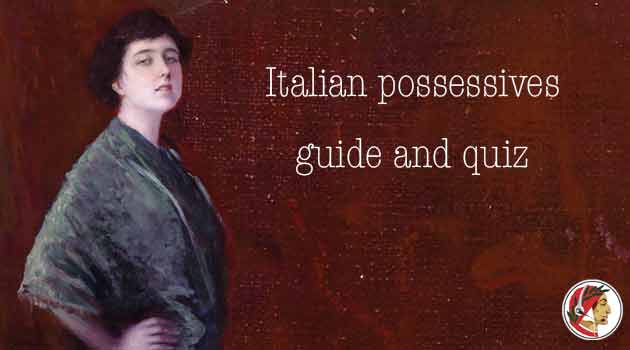The Italian Aggettivi Possessivi, are also pronouns –> Pronomi Possessivi
Aggettivi Possessivi indicate the ownership, or close relationship, between the owner and the object they possess. For example, my brother is mio fratello, and my sister is mia sorella. Their termination reflects exactly the gender and number of the object.
Singolare Maschile
il mio amico
il tuo amico
il suo amico
il nostro amico
il vostro amico
il loro amico
Singolare Femminile
la mia amica
la tua amica
la sua amica
la nostra amica
la vostra amica
la loro amica
Plurale Maschile
i miei amici
i tuoi amici
i suoi amici
i nostri amici
i vostri amici
i loro amici
Plurale Femminile
le mie amiche
le tue amiche
le sue amiche
le nostre amiche
le vostre amiche
le loro amiche
Let’s take a better look at Aggettivi and Pronomi Possessivi with the sentence below:
- La mia casa è più grande della tua – My house is bigger than yours.
The first thing we have to notice is the object casa, singular feminine noun.
- The aggettivo possessivo mia agrees with gender and number with the noun casa.
- As opposed to English, aggettivi possessivi retain the article, in this case La, which also agrees with casa. In English we can say The house or My house, not “the my house”. In Italian, with some important exceptions, there’s always an article.
- La mia casa and la tua (casa): the object casa in this comparison is the same, it is not necessary to say it again, hence … della tua (casa), where tua becomes a pronoun as yours in English.
In Italian mio aggettivo possessivo is the same mio pronome possessivo. It does not change. In English you have my and mine and so on. In Italian we don’t.
All the aggettivi possessivi agree in gender and number with the noun they refer to, except loro, which never changes.
In Italian there are no his or her based on he or she. For example:
- Ho incontrato Giorgio e sua mamma
- Ho incontrato Stefania e sua mamma
Sua refers to the mother, not to Giorgio (male) or Stefania (female).
We mentioned that in pretty much all the sentences there is a pattern
- la + mia + casa
- article + aggettivo possessivo + noun
The rule is overridden when the noun is of a family relative, only singular:
- mio fratello, tua sorella, suo nonno, mia nonna, sua mamma, tuo papà, mia cugina
but…
- i miei fratelli, i suoi nonni, i tuoi genitori, i loro cugini.
In case of Loro (their / theirs) we keep the article: —> La loro madre.
I hope this explanation of the Italian aggettivi possessivi helped you.
Please take some time to solve the quiz below about aggettivi possessivi. Feel free to book a Zoom trial class. Ciao.
LOADING QUIZ…
Pietro Scoppetta – Ritratto dell’artista Adele Carrà – 1920



Which is correct please? “Mio figlio piu’ giovane e’ bravo”.
o “Il mio figlio e’ bravo.” Grazie.
Ciao Dora.
“Mio figlio piu’ giovane e’ bravo”. E’ corretto.
“Il mio figlio e’ bravo.” E’ sbagliato.
“Il mio figlio più giovane è bravo” E’ corretto.
When you add a qualifier like “younger” or “older,” the article is used to help differentiate between the children. The version without article is generally better.